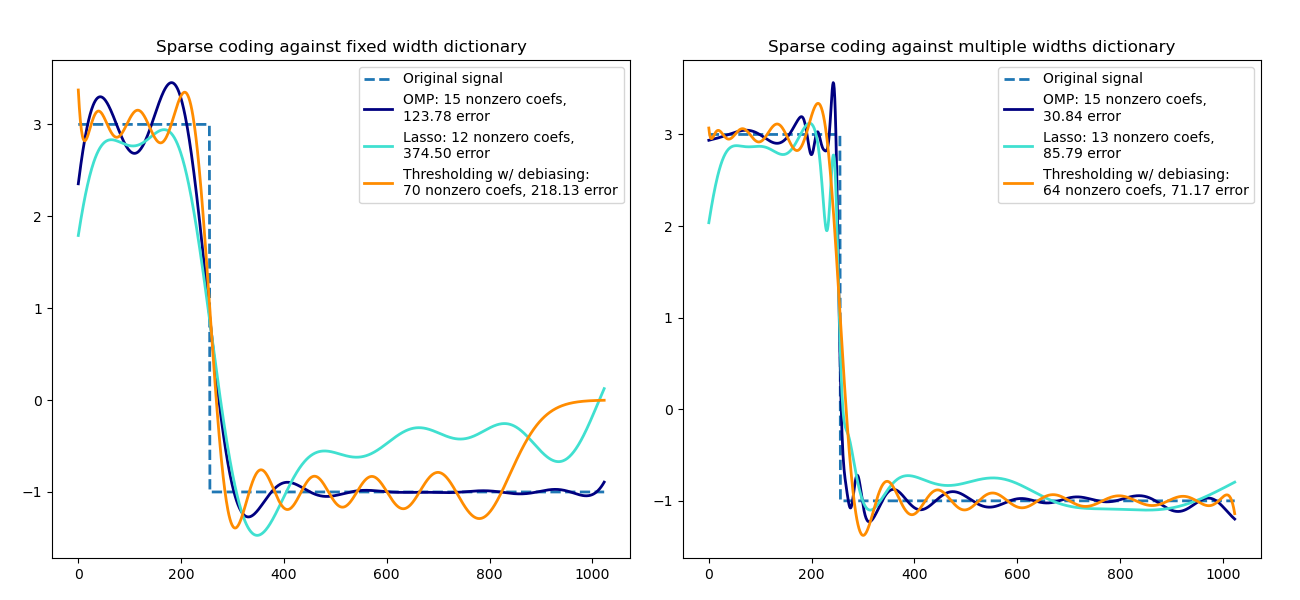Nota
Haz clic en aquí para descargar el código de ejemplo completo o para ejecutar este ejemplo en tu navegador a través de Binder
Codificación dispersa con un diccionario precalculado¶
Transforma una señal como una combinación dispersa de wavelets Ricker. Este ejemplo compara visualmente diferentes métodos de codificación dispersa utilizando el estimador SparseCoder. El Ricker (también conocido como sombrero mexicano o la segunda derivada de una gaussiana) no es un núcleo particularmente bueno para representar señales constantes a trozos como ésta. Por lo tanto, se puede ver lo mucho que importa la adición de diferentes anchos de átomos y, por lo tanto, motiva el aprendizaje del diccionario para ajustarse mejor a su tipo de señales.
El diccionario más rico de la derecha no es de mayor tamaño, ya que se realiza un submuestreo más pesado para mantenerse en el mismo orden de magnitud.

print(__doc__)
import numpy as np
import matplotlib.pyplot as plt
from sklearn.decomposition import SparseCoder
from sklearn.utils.fixes import np_version, parse_version
def ricker_function(resolution, center, width):
"""Discrete sub-sampled Ricker (Mexican hat) wavelet"""
x = np.linspace(0, resolution - 1, resolution)
x = ((2 / (np.sqrt(3 * width) * np.pi ** .25))
* (1 - (x - center) ** 2 / width ** 2)
* np.exp(-(x - center) ** 2 / (2 * width ** 2)))
return x
def ricker_matrix(width, resolution, n_components):
"""Dictionary of Ricker (Mexican hat) wavelets"""
centers = np.linspace(0, resolution - 1, n_components)
D = np.empty((n_components, resolution))
for i, center in enumerate(centers):
D[i] = ricker_function(resolution, center, width)
D /= np.sqrt(np.sum(D ** 2, axis=1))[:, np.newaxis]
return D
resolution = 1024
subsampling = 3 # subsampling factor
width = 100
n_components = resolution // subsampling
# Compute a wavelet dictionary
D_fixed = ricker_matrix(width=width, resolution=resolution,
n_components=n_components)
D_multi = np.r_[tuple(ricker_matrix(width=w, resolution=resolution,
n_components=n_components // 5)
for w in (10, 50, 100, 500, 1000))]
# Generate a signal
y = np.linspace(0, resolution - 1, resolution)
first_quarter = y < resolution / 4
y[first_quarter] = 3.
y[np.logical_not(first_quarter)] = -1.
# List the different sparse coding methods in the following format:
# (title, transform_algorithm, transform_alpha,
# transform_n_nozero_coefs, color)
estimators = [('OMP', 'omp', None, 15, 'navy'),
('Lasso', 'lasso_lars', 2, None, 'turquoise'), ]
lw = 2
# Avoid FutureWarning about default value change when numpy >= 1.14
lstsq_rcond = None if np_version >= parse_version('1.14') else -1
plt.figure(figsize=(13, 6))
for subplot, (D, title) in enumerate(zip((D_fixed, D_multi),
('fixed width', 'multiple widths'))):
plt.subplot(1, 2, subplot + 1)
plt.title('Sparse coding against %s dictionary' % title)
plt.plot(y, lw=lw, linestyle='--', label='Original signal')
# Do a wavelet approximation
for title, algo, alpha, n_nonzero, color in estimators:
coder = SparseCoder(dictionary=D, transform_n_nonzero_coefs=n_nonzero,
transform_alpha=alpha, transform_algorithm=algo)
x = coder.transform(y.reshape(1, -1))
density = len(np.flatnonzero(x))
x = np.ravel(np.dot(x, D))
squared_error = np.sum((y - x) ** 2)
plt.plot(x, color=color, lw=lw,
label='%s: %s nonzero coefs,\n%.2f error'
% (title, density, squared_error))
# Soft thresholding debiasing
coder = SparseCoder(dictionary=D, transform_algorithm='threshold',
transform_alpha=20)
x = coder.transform(y.reshape(1, -1))
_, idx = np.where(x != 0)
x[0, idx], _, _, _ = np.linalg.lstsq(D[idx, :].T, y, rcond=lstsq_rcond)
x = np.ravel(np.dot(x, D))
squared_error = np.sum((y - x) ** 2)
plt.plot(x, color='darkorange', lw=lw,
label='Thresholding w/ debiasing:\n%d nonzero coefs, %.2f error'
% (len(idx), squared_error))
plt.axis('tight')
plt.legend(shadow=False, loc='best')
plt.subplots_adjust(.04, .07, .97, .90, .09, .2)
plt.show()
Tiempo total de ejecución del script: (0 minutos 0.766 segundos)
